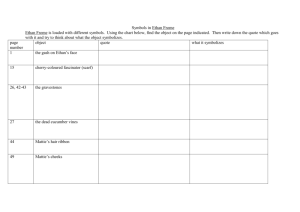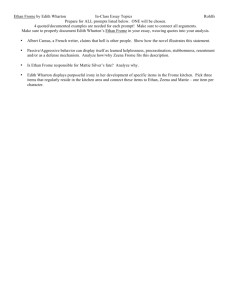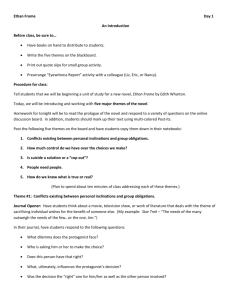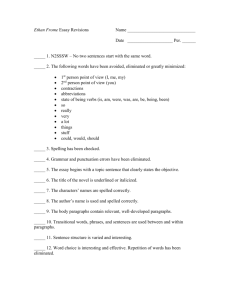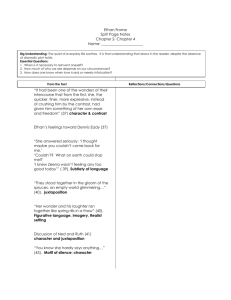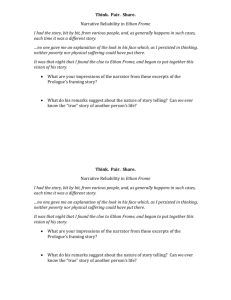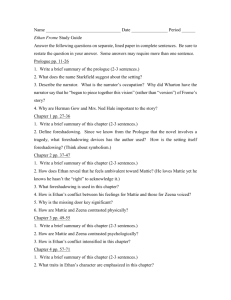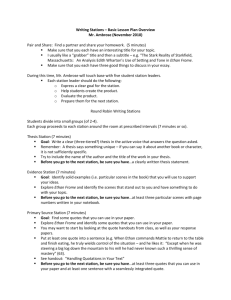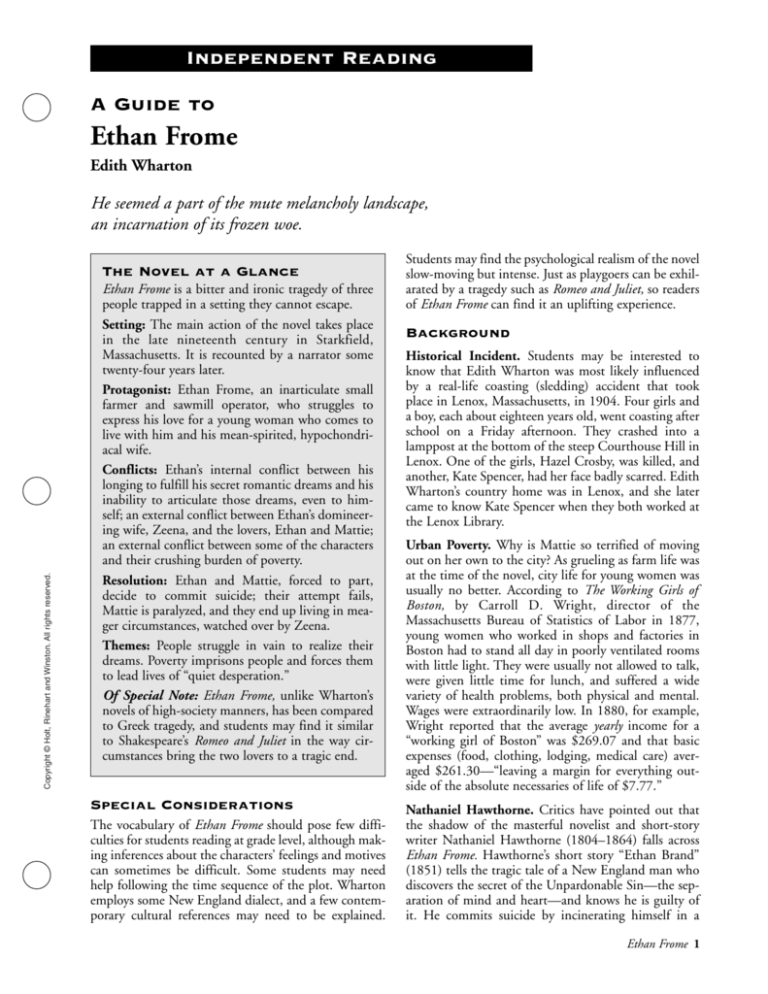
Independent Reading
A Guide to
Ethan Frome
Edith Wharton
He seemed a part of the mute melancholy landscape,
an incarnation of its frozen woe.
Copyright © Holt, Rinehart and Winston. All rights reserved.
The Novel at a Glance
Ethan Frome is a bitter and ironic tragedy of three
people trapped in a setting they cannot escape.
Setting: The main action of the novel takes place
in the late nineteenth century in Starkfield,
Massachusetts. It is recounted by a narrator some
twenty-four years later.
Protagonist: Ethan Frome, an inarticulate small
farmer and sawmill operator, who struggles to
express his love for a young woman who comes to
live with him and his mean-spirited, hypochondriacal wife.
Conflicts: Ethan’s internal conflict between his
longing to fulfill his secret romantic dreams and his
inability to articulate those dreams, even to himself; an external conflict between Ethan’s domineering wife, Zeena, and the lovers, Ethan and Mattie;
an external conflict between some of the characters
and their crushing burden of poverty.
Resolution: Ethan and Mattie, forced to part,
decide to commit suicide; their attempt fails,
Mattie is paralyzed, and they end up living in meager circumstances, watched over by Zeena.
Themes: People struggle in vain to realize their
dreams. Poverty imprisons people and forces them
to lead lives of “quiet desperation.”
Of Special Note: Ethan Frome, unlike Wharton’s
novels of high-society manners, has been compared
to Greek tragedy, and students may find it similar
to Shakespeare’s Romeo and Juliet in the way circumstances bring the two lovers to a tragic end.
Special Considerations
The vocabulary of Ethan Frome should pose few difficulties for students reading at grade level, although making inferences about the characters’ feelings and motives
can sometimes be difficult. Some students may need
help following the time sequence of the plot. Wharton
employs some New England dialect, and a few contemporary cultural references may need to be explained.
Students may find the psychological realism of the novel
slow-moving but intense. Just as playgoers can be exhilarated by a tragedy such as Romeo and Juliet, so readers
of Ethan Frome can find it an uplifting experience.
Background
Historical Incident. Students may be interested to
know that Edith Wharton was most likely influenced
by a real-life coasting (sledding) accident that took
place in Lenox, Massachusetts, in 1904. Four girls and
a boy, each about eighteen years old, went coasting after
school on a Friday afternoon. They crashed into a
lamppost at the bottom of the steep Courthouse Hill in
Lenox. One of the girls, Hazel Crosby, was killed, and
another, Kate Spencer, had her face badly scarred. Edith
Wharton’s country home was in Lenox, and she later
came to know Kate Spencer when they both worked at
the Lenox Library.
Urban Poverty. Why is Mattie so terrified of moving
out on her own to the city? As grueling as farm life was
at the time of the novel, city life for young women was
usually no better. According to The Working Girls of
Boston, by Carroll D. Wright, director of the
Massachusetts Bureau of Statistics of Labor in 1877,
young women who worked in shops and factories in
Boston had to stand all day in poorly ventilated rooms
with little light. They were usually not allowed to talk,
were given little time for lunch, and suffered a wide
variety of health problems, both physical and mental.
Wages were extraordinarily low. In 1880, for example,
Wright reported that the average yearly income for a
“working girl of Boston” was $269.07 and that basic
expenses (food, clothing, lodging, medical care) averaged $261.30—“leaving a margin for everything outside of the absolute necessaries of life of $7.77.”
Nathaniel Hawthorne. Critics have pointed out that
the shadow of the masterful novelist and short-story
writer Nathaniel Hawthorne (1804–1864) falls across
Ethan Frome. Hawthorne’s short story “Ethan Brand”
(1851) tells the tragic tale of a New England man who
discovers the secret of the Unpardonable Sin—the separation of mind and heart—and knows he is guilty of
it. He commits suicide by incinerating himself in a
Ethan Frome 1
Main Characters
(in order of appearance)
Narrator, a young visiting engineer who pieces together
the story of Ethan Frome from various sources in
Starkfield.
Ethan Frome, an impoverished New England farmer
and sawmill operator, twenty-eight years old at the time
of the main story. He is an inarticulate man of passionate feelings, romantic longings, and unrealized dreams.
Harmon Gow, former Starkfield stagecoach driver and
“village oracle.”
Mrs. Ned Hale (Ruth Varnum), the narrator’s talkative widowed landlady.
Denis Eady, cheerful young man who admires and
flirts with Mattie in the main story and later becomes a
well-to-do grocer.
Mattie Silver, Zeena Frome’s cousin who comes to live
with the Fromes. Lively yet delicate, she becomes the
object of Ethan’s romantic yearnings.
Zeena (Zenobia) Frome, Ethan’s wife, seven years his
senior. A bitter, domineering woman, jealous and fearful, obsessed with her own illnesses.
Andrew Hale, Starkfield house builder who, like
Ethan, has fallen on hard times.
Jotham Powell, Frome’s hired hand, a man of few words.
Plot
The short novel, or novella, opens in Starkfield,
Massachusetts, as the narrator, a visiting engineer, tells
the frame story from the first-person point of view.
He says that he first saw Ethan Frome several years earlier and gradually gathered bits of Frome’s story from
various people. Harmon Gow told him that Frome’s
terrible “smash-up” had occurred twenty-four years earlier. The narrator emphasizes the effect of the bare, wintry setting on the “deadness of the community.” He
then describes his meeting with Frome, who is hired as
his driver. He lends Frome a book but cannot penetrate
the farmer’s reticence. When Frome and the narrator
are caught in a snowstorm, however, they take shelter at
Frome’s farm. Then ellipses indicate a flashback to
twenty-four years earlier.
Chapter 1. The inner story begins, told from the
third-person point of view. The exposition reveals the
2 Ethan Frome
novel’s central external conflict—Ethan’s silent battle
against his wife, Zeena, over his love for Mattie, who
has come to live with the Fromes as Zeena’s helper.
When Ethan goes to town to escort Mattie home from
a church dance, he stands alone outside the church and
secretly watches her whirling with young Denis Eady.
In Mattie, Frome has discovered someone with whom
he can talk and express his wonder at nature. Mattie,
however, is unsuited to farm work, and Ethan often
does her chores for her. Zeena, sickly and whiny, has
become suspicious and has suggested that Mattie may
soon leave to marry Denis Eady. Still looking in at the
dancers, Ethan is filled with misgivings.
Chapter 2. Ethan watches with secret exultation as
Mattie talks with Eady but rejects his offer of a sleigh
ride. Ethan catches up to Mattie, and, as they stand arm
in arm, Mattie remarks that she would like to go coasting (sledding) one night. Ethan agrees to go coasting
with her the following night, and Mattie foreshadows
the end of the novel when she says that her friends Ned
and Ruth were almost killed coasting into an elm tree.
In the novel’s main internal conflict, Ethan’s love for
Mattie fills him with elation, but he is unable to express
his feelings openly. Ethan and Mattie arrive home, and
seeing the Frome family graveyard—a symbol of the
burden of the past that Ethan carries, the long chain of
ancestors that binds him to the land—gives Ethan a
sense of stability. Zeena, who says she feels “too mean”
to sleep, meets them at the door, and Ethan reluctantly
follows Zeena into their bedroom.
Chapter 3. The tension rises as a surprising complication develops. When Ethan enters the house at midday,
Zeena is dressed and packed, ready to spend the night
with her Aunt Martha Pierce in Bettsbridge. Absorbed
in the details of her own illnesses, Zeena says she is going
there to see a new doctor. Ethan, thinking only of the
possibility of a night alone with Mattie, makes an excuse
so that he will not have to drive Zeena: He says that he
needs to see the builder Andrew Hale to collect a payment and that Jotham, the hired man, can drive Zeena.
Chapter 4. Zeena leaves. She is further characterized
as we learn that she had nursed Ethan’s mother and won
his gratitude. Zeena and Ethan then married and
planned to move to a town where Ethan could pursue
a career as an engineer. They could not sell the Frome
farm, however, and Zeena, disappointed and resentful
at her married life, grew taciturn and sickly. The main
story continues as Ethan, regretting that he mentioned
obtaining cash from Hale, drives to Hale’s lumberyard
to ask for a small payment. He is not surprised when
Hale refuses. Ethan returns home, and at supper that
evening, Zeena’s name keeps disconcerting both Ethan
and Mattie. The house cat, a symbol of Zeena, knocks
one of Zeena’s precious possessions, a pickle dish, to the
floor, and it shatters. Mattie fears the consequences
when Zeena discovers the broken dish, but Ethan plans
to glue the pieces together and later buy a replacement.
Copyright © Holt, Rinehart and Winston. All rights reserved.
limekiln; when he is found, all that is left of him is a
piece of marble in the shape of a heart. Zeena’s name
recalls Zenobia in Hawthorne’s The Blithedale Romance
(1852). The historical Zenobia, queen of Palmyra in
the latter part of the third century A.D., arrogantly and
unwisely confronted the Roman Empire. Hawthorne’s
Zenobia (modeled also on the writer and social
reformer Margaret Fuller) is a proud and commanding
woman who is defeated in love and drowns herself.
Chapter 5. The single scene in this chapter is tense
with repressed emotion, and Wharton uses several
methods of characterization: She shows us Ethan’s and
Mattie’s actions; she reveals the characters’ effects on
each other (when Mattie blushes, for example); she tells
how they look and how they speak (“uncertainly,” for
example); and she reveals Ethan’s (but not Mattie’s) private thoughts and feelings. After dinner, Ethan tells
Mattie to sit in Zeena’s chair. She does so but seems
uneasy and moves to another chair to see her sewing
better. The cat jumps into Zeena’s chair and watches the
couple “with narrowed eyes.” Ethan and Mattie converse easily, and Ethan feels as if they were married.
When Ethan reaches out to touch the fabric Mattie is
sewing, the cat suddenly springs at a mouse and sets
Zeena’s chair rocking, as if Zeena were somehow present in the room. Ethan kisses the fabric in his hand, but
Mattie stands up and puts away her sewing things.
They put out the lamp and bid each other goodnight.
Ethan realizes that during the entire evening he has
never even touched Mattie’s hand. Mattie has not indicated openly that she recognizes Ethan’s feelings for her.
Copyright © Holt, Rinehart and Winston. All rights reserved.
Chapter 6. At breakfast the next morning Ethan is happy
with his vision of how life with Mattie might be. He plans
to haul a load of lumber to the village in the afternoon,
when the icy roads may be more passable, and to send
Jotham to pick up Zeena. Icy rain and an injury to one of
the horses delay the trip to the village, where he also wants
to buy glue to repair the broken pickle dish. He eventually drives to the village and unloads the lumber as fast as
he can but loses time buying the glue. When he returns
home, Zeena has already arrived and gone to her room.
Chapter 7. When Ethan asks Zeena to come to supper,
she tells him that she is suffering from “complications,”
that she needs an operation, and that the new doctor
told her to hire a girl to do all her work. She announces
that the hired girl will arrive tomorrow and that she has
agreed to pay her one dollar extra. This news fills Ethan
with anger and dismay, and they argue fiercely. When
Zeena says she intends to send Mattie away, Ethan is
overwhelmed by his hatred for Zeena, yet he makes no
effective response. He sits down to supper with Mattie
but, unable to eat, embraces her, kisses her, and reveals
that Zeena wants her to leave. Zeena appears, eats a
substantial supper, and discovers the broken pickle
dish. Ethan blames the cat, but Mattie admits taking
the dish to set a pretty table. Zeena, infuriated, rages at
Mattie for taking the one thing she most treasured.
Chapter 8. Ethan rages inwardly against the prospect
of being tied to such a bitter woman for the rest of his
life. He remembers a man who escaped to the West
with the woman he loved; the man’s wife divorced him
and prospered. He begins writing a note to Zeena outlining such a plan but realizes that the farm and the mill
are mortgaged and that he has no money at all to start
a new life. Trapped, he sees himself as “a prisoner for
life.” He falls asleep thinking of coasting with Mattie.
In the morning, Ethan is unable to stop Zeena’s plan
to have Mattie’s trunk sent on ahead with Daniel
Byrne. He thinks of going to the West with Mattie, but
he needs funds to pay for the trip. On his way to
approach Hale again for money, he meets Mrs. Hale,
who speaks to him kindly. Suddenly Ethan realizes that
he was going to try to take advantage of the Hales’ sympathy. He turns and walks slowly back to the farm.
Chapter 9. The plot comes to a climax. After dinner,
Ethan asserts that he, not Jotham, will drive Mattie to
the train, directly contradicting Zeena. They leave in
the sleigh, but Ethan drives to Shadow Pond, where
they reminisce about a church picnic. As the sun sets,
they return to the Starkfield road. Mattie tells Ethan she
found the letter he had started to write the night before,
and she shows it to him. He tells her that he wishes he
could go with her, but he cannot—and she tears up the
letter. They profess their deep feeling for each other,
and Ethan says he would almost rather she were dead
than married to someone else.
They remember their plan to go coasting, and Ethan
suggests they do it now. They find a sled among some
spruces and coast down the hill. Exhilarated, they climb
back up the hill and embrace, unable to part, as the clock
strikes five. Suddenly, Mattie says that she wants Ethan
to take her down the hill again, this time not missing
the elm tree—so that they will “never come up any
more.” Ethan is astounded, but the thought of his life
with Zeena is unbearable. He takes the front seat on the
sled and crashes head-on into the tree. A few moments
later, he regains consciousness, hears Mattie whisper his
name, and moans. Ironically, the lovers have not died.
In the resolution, the narrator resumes the firstperson frame story at the point where he left off in the
prologue—entering the Frome house during the snowstorm. He is introduced to a tall, slatternly woman—
Zeena—and to a smaller woman sitting immobile in a
chair—Mattie. The narrator returns the next day to talk
with Mrs. Hale. She says that she stayed with Mattie all
night after the crash, but she breaks off before revealing
what Mattie said to her. Zeena stayed with Ethan and
eventually took Mattie back to the farm, where she has
remained ever since. Mrs. Hale feels that Mattie has
soured, that Zeena has shouldered the burden of caring
for Ethan and Mattie, and that Ethan has probably suffered the most, especially when the two women argued.
She reveals that she thinks Mattie would have been better off dead, implying that this is what Mattie said to
her on the night of the smash-up. She sees little difference between the Fromes in the farmhouse and the
Fromes in the graveyard.
Approaches for
Post-Reading Activities
The major elements of Ethan Frome—characters, conflicts, theme, style—seem to have grown naturally out
of its setting:
Ethan Frome 3
Students in discussion groups or doing individual
research projects might focus on some of the following
activities.
1. Investigating the Historical Background
One of the interesting questions raised by the character of Mattie in the novel concerns the position of
women in turn-of-the-century American society.
Students could investigate any of the following topics:
• the economic and social problems women faced
(such as low wages and health concerns) and the psychological effects of the limited options open to them
• the differences between the conditions of urban
and rural women at that time (farm workers and
factory workers, for example)
• the social and cultural changes that have taken
place since and how the world of Ethan Frome
compares with the world today
2. Evaluating Characters and Decisions
Discussion groups might focus on one or more of the
following questions dealing with the novel’s characters:
• Are the characters of Ethan, Mattie, and Zeena true
to life?
• Do Ethan and Mattie make wise decisions? What
alternatives might they have considered?
• How are Ethan, Mattie, and Zeena like or unlike
other characters in books or movies?
3. Making a Time Line
Students might make a time line that identifies the
sequence (not the exact dates) of the major events of
the frame and inner stories of Ethan Frome.
Meet the Writer
Edith Newbold Jones Wharton (1862–1937) was
born in New York City into a wealthy and distinguished family and was educated by private tutors. In
1885, she married Edward (“Teddy”) Wharton, and the
Copyright © by Holt, Rinehart and Winston, Inc.
All rights reserved. No part of this publication may be reproduced
or transmitted in any form or by any means, electronic
or mechanical, including photocopy, recording, or any information
storage and retrieval system.
Printed in the United States of America
4 Ethan Frome
couple maintained residences in New York; Newport,
Rhode Island; Paris; and Lenox, Massachusetts. After
their divorce in 1913, Edith Wharton settled permanently in Paris where, during World War I, she was
actively involved in war-relief work.
Wharton published a variety of books, beginning
with a collection of short stories in 1899. Her bestknown novels, besides Ethan Frome (1911), include
The House of Mirth (1905), The Age of Innocence (1920,
Pulitzer Prize), and Hudson River Bracketed (1929).
Strongly influenced by Henry James, Wharton
believed, as she wrote in The Writing of Fiction (1925),
“every great novel must first of all be based on a profound sense of moral values, and then constructed with
a classical unity and economy of means.” Wharton also
wrote travel books, poems, essays, and an autobiography.
Read On
Edith Wharton, The Age of Innocence. Wharton’s celebrated novel of manners tells a story of thwarted love
in New York’s highest social circles. A noted film version appeared in 1993.
Edith Wharton, Ethan Frome. Feature film starring
Liam Neeson and Patricia Arquette (available from
Buena Vista Home Video, 1992).
Edith Wharton, Ethan Frome. Sound recording of the
novel on four audiocassettes, read by Richard Thomas
(Dove Audio, 1993).
Emily Brontë, Wuthering Heights. A great novel
(1847) of thwarted love set on England’s Yorkshire
moors. Wharton said she was influenced by this passionate novel when she was writing Ethan Frome. There
are obvious similarities between the two novels.
Nathaniel Hawthorne, “Ethan Brand.” A classic
short story, featuring a tragic hero whose heart is literally made of stone.
Kate Chopin, “A Pair of Silk Stockings.” A short story
of a woman’s assertion of independence and individuality.
Sarah Orne Jewett, The Country of the Pointed Firs.
“Local color” sketches (1896) of Maine that Wharton
considered too “rose-colored” to be authentic, compared with the heart-rending realism of Ethan Frome.
Robert Frost, “The Death of the Hired Man.” A dramatic lyric in blank verse about a defeated man who is
not at home in the modern world.
Copyright © Holt, Rinehart and Winston. All rights reserved.
• The harsh New England landscape dominates the
lives of those forced to battle it every day. Some
characters are as hard and as unforgiving as their
environment; those with weak or romantic temperaments are destroyed.
• Rural poverty underlies one of the novel’s conflicts; the setting also reinforces our sense that the
characters are trapped, just as surely as the Fromes’
farm is frozen in the winter snow.
• The style is as spare, straightforward, and
unadorned as the granite landscape.

